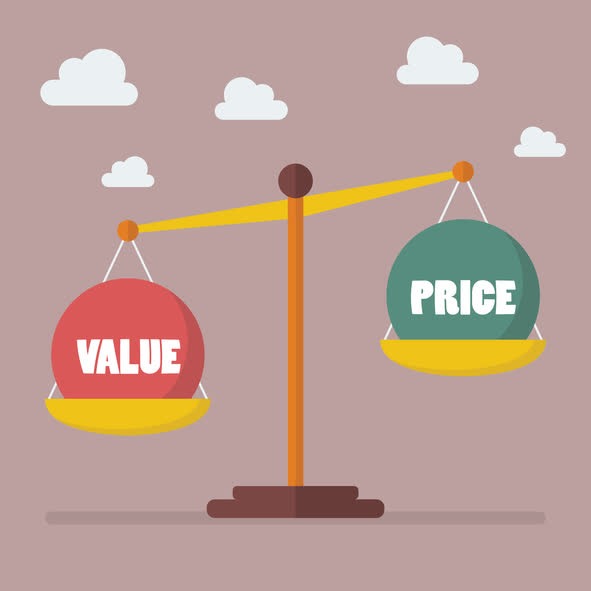Dividend Value Builder Newsletter
Shiller PE 10: Advantages, Criticisms, and Implementation

The purpose of Shiller PE 10 is to provide long term risk to reward analysis based on earnings and current prices. Used properly, this metric will guide you to asset allocation decisions that improve your long term returns and lower risk of large portfolio drawdowns.
What is Shiller PE 10?

Professor Robert Shiller of Yale University developed the Shiller PE 10 to more accurately reflect long term trends and smooth volatile components of the standard P/E ratio. It is also known as the Cyclically-Adjusted P/E ratio (CAPE). The “10” represents the rolling 10 year periods Shiller uses to calculate PE 10.
The PE 10 for the S&P500 is the price of the index divided by 10 year inflation adjusted average earnings. The calculation is: S&P 500 annual earnings for the each of the past 10 years adjusted each year for inflation (using the CPI); then calculate the average for the decade. This number is then divided into the price of the S&P 500 to get the current Shiller PE 10.
The higher the Shiller PE the more overvalued the market is historically. The lower the ratio the more undervalued the market is historically. More information can be found at Multpl.com including valuable charts.
Advantages of Shiller PE 10
Profit margins and earnings are cyclical in nature; therefore the standard and widely popular P/E ratio can be quite volatile. The earnings for any one year may not reflect true earnings because they are affected by expanding and contracting business cycles. For example in the first quarter of 2009, a short term collapse in earnings caused the standard P/E ratio to rise over 100 at a time the market was clearly undervalued and near a bottom.
Shiller PE 10 uses rolling ten year periods to average or smooth earnings. Therefore the ratio provides a better representation of long term earnings trends by showing a version of the P/E that is smoothed out over a number of years.
Shiller was able to show that the P/E 10 at any given time was correlated to what market returns would be over the next 20 years. In simplified terms, if the ratio is high the expected rate of return for the next 20 years is lower than average. But when the ratio is low the expected rate of return for the next 20 years is higher than average.
In my opinion, the research into valuation based strategies is strong. Valuation investing improves risk adjusted returns compared to strategic or fixed asset allocations.
Criticisms of Shiller PE 10
There are criticisms of the Shiller PE 10, most of which I believe are unjustified. Some investors believe that the market is efficient and would not provide extraordinary returns to someone just because they invest in the market when valuations are low; however historical evidence proves them wrong.
Another criticism is that it is a long term indicator and does not provide enough buy and sell “signals”. This criticism is evidence that too many investors are focused on short term results and too impatient to think long term.
In addition I believe these critics take the metric too seriously. There are no set rules for buying or selling. There are no “magic formulas” that give exact answers. However the general valuation of the market, as presented by Shiller PE 10, gives the analyst a frame of reference to judge the balance between risk and reward.
Implementing Shiller PE 10 In Your Portfolio Asset Allocation
I don’t advocate use of many iron clad rules. This isn’t a scientific formula that makes your research and homework go away. However, this is how I implement the ratio into my portfolio asset allocation:
When Shiller PE 10 is Low:
I know the odds of higher than average long term returns are in my favor when the ratio is low; therefore I increase my asset allocation to equities.
I also know the odds are better for the entire market when the ratio is low. Therefore I lean towards strategies that are more diversified. This might include owning a greater number of stocks, or including ETFs or low cost index funds in my asset allocation.
Summary: The lower the ratio the higher percentage I allocate to equities and broad diversification through market index funds, ETFs, or individual stocks.
Summary: I will increase my allocation to equities and employ broader diversification when the the ratio is low.
Interested in Intrinsic Value Stock Analysis?
When Shiller PE 10 is High:
The odds of lower than average long term returns are expected when the ratio is high; therefore I decrease my asset allocation to equities.
I also know, because of higher risk, I need a higher margin of safety in the investments I choose. This means I will place a higher percentage (maybe even 100%) of my equity allocation in individual stocks, instead of index funds or ETFs. This allows me too tightly control my risk and only invest in individual companies that meet my margin of safety requirements.
Summary: I allocate a lower percentage to equities when the ratio is high and lean towards concentration in individual stocks which offer a high margin of safety.
Stock Market Valuation and Shiller PE 10
The Shiller ratio is not a magic formula to make your asset allocation decisions for you. It is a valuable stock market valuation tool for risk/reward management. The ratio will guide you to asset allocation decisions that improve long term returns and lower your risk of large portfolio drawdowns.
Minimize Large Portfolio Drawdowns
Invest With Confidence in Less Time - Manage Your Portfolio Without Behavioral Errors
